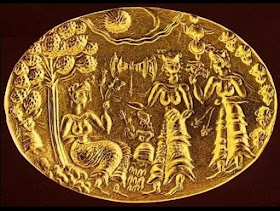Morris and Peatfield used this ring as their typological image for their altered states of consciousness hypothesis, whereas Gimbutas considered the image to provide evidence for the continuity of bee-worship and honey-rituals from Neolithic European cultural horizons down to the Aegean Bronze Age. Vasilakis considered this ring to exemplify Minoan dance circular dance rituals. Rehak considers this ring to show some kind of rite pertaining to young adult women, rather than an epiphany scene.Which makes this a good introduction to the subject of Minoan and Mycenaean signet rings, wonderful little things that seem charged with meaning, if only we could figure out what it is.
The so-called Minos Ring, which has an interesting story. It was found by a boy, a farmer's son, who handed it over to a priest described by Evans as "meddlesome." The priest brought it to Evans, who thought it was genuine and offered to buy it, but the priest asked for a sum Evans refused to pay, and no deal was struck. But the priest did allow Evans to take an impression of the seal, from which he made two copies that are now in the Ashmolean (one is above). In 1934 the priest turned to the Museum of Iraklion, but the Greek archaeologists there could not agree on whether it was genuine, so they refused to buy it. Years later they decided they did want it after all, but the priest reported that it had been lost, and it has not been seen since. As to what it depicts, well, go ahead and guess -- what you come up with can't be any wilder than some of the theories that have already been published. The story of King Minos? A feud of goddesses?
A ring showing a bull dancer, from Akarnes, Crete, which may date to c. 1700 BCE but on the other hand may be a 20th-century fake.
This fascinating ring came from the Tiryns Treasure, c. 1500 BCE. The two priestesses or goddesses are accompanied by a young male figure who tends to an impressive plant. This is conventionally interpreted as giant fennel, which it indeed resembles, and which has many ancient, magical associations. But others think it is the extinct and even more magical plant silphium, revered in the ancient world as both an aphrodisiac and a means of birth control.
From a tomb on Poros. Does the right-hand section depict the same scene as above?
The so-called Ring of Theseus, found at Athens in the 1950s. The authenticity of this ring has also been disputed, but both the ring and the circumstances of its discovery were minutely examined by a panel of Greek archaeologists in 2006, and they insisted that it is genuine.
Griffin ring from the tomb of gold rings at Phourni.
And here is my favorite of these rings, the so-called Ring of Nestor. Evans acquired this in Pylos in 1924, after hearing from "a friend" that it might be for sale. Evans wrote an entire long article about the ring, saying:
On the remarkable gold signet-ring, known from the place of its discovery [Mycenaean Pylos] as the 'Ring of Nestor', the scenes of initiation into the after-life are divided by the trunk and branches of a Minoan 'Tree of the World'. Here there can be little doubt...that the plant, the shoots of which spring forth from the trunk to give shade to the lion guardian of the realms below, must be identified with the same 'Sacral Ivy' that climbs the rocky steeps in this cycle of wall paintings....May we not perhaps go even farther? This conspicuous spray - with its green leaves picked out, as we see them in the fresco, by the bright orange outline of the sacred emblem - springing from the hoar and barren trunk of the tree that here seems to stand on the borders of the Minoan Underworld, might it not itself have possesed some mystic power? It is impossible not to recall the Golden Bough, which, when plucked by Aeneas, opened for him the passage to Avernus. But ever, as one was torn away, another branch of gleaming gold sprang in its place.While Evans was convinced that the ring was genuine, many have been just as convinced that it was a fake. In the 1950s the Ashmolean Museum took it out of the display case and hid it away in a back room. But then in the 1990s the ring came back into favor with scholars and went back on display in the Ashmolean; today its status remains disputed. Archaeologists tend to doubt the ring's authenticity. On the other hand comparative mythographers mostly believe in it, because they think it includes information about the ancient strata of European myth to which no forger would have had access in 1924. I think the very weird subject matter argues for authenticity; if you wanted to sell Arthur Evans a fake ring, wouldn't you choose a theme he already believed was important in Minoan art, like the bull dancing ring? Why dream up this bizarre mishmash of Norse, Egyptian, and Minoan imagery? If it is genuine it adds another chapter to the worldwide mythography of the world tree, with a monster at its root and divine kingdoms in its branches.
It is a little sad that some of these rings may not be what they seem. But at least a dozen have come from good archaeological contexts at Knossos, Mycenae, Tiryns, and Phourni, and they are enough to open a magical golden window into the Bronze Age past.
UPDATE
UPDATE 2
More rings from the tombs in Pylos! The top two are both thought to represent goddesses, the second one shown on a mountaintop with birds.
UPDATE 3
Drawings of yet more rings from Mycenae, from an article Arthur Evans published in 1901. The one above shows an ancient design of two noble beasts and a pillar, the same design famously used over the gate of the citadel.

























No comments:
Post a Comment